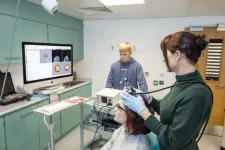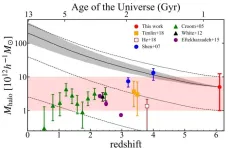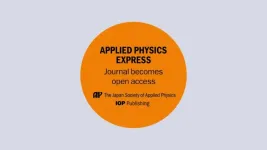(Press-News.org) The targeted use of ultrasound technology can bring about significant changes in brain function that could pave the way towards treatment of conditions such as depression, addiction, or anxiety, a new study suggests.
Research by neuroscientists at the University of Plymouth explored the impacts of an emerging technique called transcranial ultrasound stimulation (TUS).
Typically, ultrasound examinations involve diffuse broad beams of ultrasound being used to create images while leaving the target tissue unaffected.
However, focusing the beams through TUS can increase the pressure in the target region and change the way neurons communicate with one another.
Writing in Nature Communications, the research team say a study involving 24 healthy adults showed that TUS can induce significant changes in GABA (gamma-aminobutyric acid) concentration within the brain’s posterior cingulate cortex in the hour following ultrasound treatment.
The study also showed that in the hour following the TUS treatment, the way the posterior cingulate cortex communicates with the rest of the brain was also profoundly altered.
However, the changes were not consistent across all areas with GABA levels not being altered in the anterior cingulate cortex, another cortical area equally related to psychiatric conditions but underlying different cognitive functions, particularly related to decision making, learning and attention regulation.
The research team – which also included experts from the University Hospitals Plymouth NHS Trust, University College London, Radboud University Nijmegen, and University of Oxford – say the study represents an important first step in the generation of clinical applications that could use ultrasound to treat mental health disorders.
They say the study provides evidence that TUS works in humans and that changes in the brain are reversible, although much more work will need to be done before it can be applied in a clinical setting.
They are already exploring whether TUS can be used to change the dopaminergic system, which could potentially alter how people make decisions, learn, and are motivated to engage in certain behaviours relevant to addiction.
Senior author Dr Elsa Fouragnan, Associate Professor of Neuroscience at the University of Plymouth and a UK Research and Innovation Future Leaders Fellow, said: “One of the long-term aspirations of neuroscientists is to find ways to change activity in only certain parts of the brain while leaving the rest unchanged. If you are taking medication for depression, for example, the drug will impact the entire brain and clinicians have very limited control over where the drug goes and what it does. We already know that specific regions of the brain (and some of their connections) are dysfunctional in certain conditions but other regions can work perfectly well. This study provides us with the genuine potential to think about using ultrasound for more targeted interventions in people with a range of mental health conditions.”
Dr Siti Yaakub, a Postdoctoral Research Fellow at the University and the study’s lead author, added: “It was very interesting to see that when we targeted two different brain regions, it resulted in different changes in GABA concentration. This suggests that some TUS protocols work well for certain parts of the brain and not so well for others. Or maybe there is another mechanism at play, like the fact that the region needs to be in a certain state for the intervention to work, and that is something we clearly need to explore more in future work.”
The study was carried out at the University of Plymouth’s Brain Research and Imaging Centre, a state-of-the-art research facility opened in 2022 to help better understand brain activity and human behaviour.
It is the latest project involving the University to explore the impact of ultrasound on the human brain, with previous studies highlighting how ultrasound could be used to treat psychiatric disorders and change the decision-making process.
END
Targeted ultrasound can change brain functions for up to an hour after intervention
A study published in Nature Communications suggests transcranial ultrasound stimulation can be used in a targeted way to change specific types of activity within the brain
2023-09-12
ELSE PRESS RELEASES FROM THIS DATE:
U.S. advocacy strategy nets a 25 percent increase in lung cancer research funding
2023-09-12
[Singapore, 10:05 a.m. SGT--September 12, 2023] - A unified and concentrated lung cancer advocacy program in the United States resulted in a 25 percent increase in funding to a U.S.-based lung cancer research program, according to a presentation given today at the International Association for the Study of Lung Cancer 2023 World Conference on Lung Cancer in Singapore.
Lung cancer remains a major health concern, with mortality rates posing a significant challenge both globally and in the United States. The U.S. Department of Defense Congressionally Directed Medical Research Program/Lung Cancer Research Program (LCRP) was established in 2009 with a funding level of $20 million, but ...
IASLC staging model for mesothelioma validated; study supports continued use of model
2023-09-12
[Singapore, 10:05 a.m. SGT--September 12, 2023] – A model developed by the International Association for the Study of Lung Cancer in 2009 to help better stage mesothelioma cases performed well, according to an independent analysis presented today at The International Association for the Study of Lung Cancer (IASLC) 2023 Conference in Singapore.
Pleural mesothelioma is a rare but aggressive cancer primarily caused by asbestos exposure and presents complex challenges for effective staging and prognostication. The IASLC took a significant step in 2009 by establishing an international pleural mesothelioma database aimed at enhancing staging ...
Long-term outcomes of radiation techniques for locally advanced non-small cell lung cancer presented at IASLC 2023 Conference in Singapore
2023-09-12
[Singapore, 10:05 a.m. SGT--September 12, 2023] - Intensity-modulated radiation therapy, or IMRT, should be utilized for locally advanced NSCLC to reduce the risk of severe pulmonary toxicity and radiation exposure to the heart, according to research presented today at the International Association for the Study of Lung Cancer 2023 World Conference on Lung Cancer in Singapore.
Dr. Stephen Chun, MD Anderson in Houston, Texas, presented a comprehensive analysis of the phase III trial NRG Oncology-RTOG 0617, comparing intensity-modulated radiation therapy (IMRT) with 3D-conformal ...
Reproductive factors associated with higher risk of lung cancer in women
2023-09-12
[Singapore, 10:05 a.m. SGT--September 12, 2023] - A study presented at the International Association for the Study of Lung Cancer 2023 World Conference on Lung Cancer revealed that key reproductive factors such as early menopause, shortened reproductive span, and early age at first birth are associated with elevated risks of lung cancer in women.
Researchers from Xiangya Hospital, Changsha, Hunan, China, conducted a prospective cohort study involving 273,190 participants from the UK Biobank to delve into the links between individual reproductive ...
Dark matter halos measured around ancient quasars
2023-09-12
At the center of every galaxy is a supermassive black hole. Beyond a certain size, these become active, emitting huge amounts of radiation, and are then called quasars. It is thought these are activated by the presence of massive dark matter halos (DMH) surrounding the galaxy, directing matter towards the center, feeding the black hole. A team including researchers from the University of Tokyo have, for the first time, surveyed hundreds of ancient quasars and found this behavior is very consistent throughout history. This is surprising, as many large-scale processes show variation throughout the ...
Arf1 inhibitors promote the infiltration of cytotoxic T lymphocytes into tumors by affecting lipid metabolism
2023-09-12
In recent years, cancer immunotherapies, represented by immune checkpoint blockade (ICB), have been highly successful and have become an important basis for the future treatment of cancers. However, the absence of tumoral killer T cells and the complexity of tumor microenvironment can both affect the immunotherapeutic efficacy. Therefore, it is urgent to develop novel anti-tumor agents that can effectively promote effector T cell infiltration in tumors.
ADP-ribosylation factor 1 (Arf1) is a member of the Ras small GTPase family and is ...
Intensity-modulated radiation therapy provides long-term benefits to patients with locally advanced lung cancer
2023-09-12
Intensity-modulated radiation therapy (IMRT) should be the preferred choice when treating patients with locally advanced non-small cell lung cancer (NSCLC), as it reduces radiation exposure to the heart and lungs, according to researchers at The University of Texas MD Anderson Cancer Center.
Results from a long-term secondary analysis of the NRG Oncology-RTOG 0617 Phase III study, with a median follow-up of 5.2 years, revealed that patients receiving IMRT had a more than two-fold reduction in severe lung inflammation (pneumonitis) compared to those who received 3D-conformal radiotherapy ...
New super-fast flood model has potentially life-saving benefits
2023-09-12
Published in Nature Water, the new model has major potential benefits for emergency responses, reducing flood forecasting time from hours and days to just seconds, and enabling flood behaviour to be accurately predicted at super-fast speeds as an emergency unfolds.
University of Melbourne PHD student Niels Fraehr, alongside Professor Q J Wang, Dr Wenyan Wu and Professor Rory Nathan, from the Faculty of Engineering and Information Technology, developed the Low-Fidelity, Spatial Analysis ...
In maize, co-expression of GAT and GR79-EPSPS provides high glyphosate resistance, along with low glyphosate residues
2023-09-12
This study is led by Dr Zhihong Lang (Biotechnology Research Institute, Chinese Academy of Agricultural Sciences). To develop a new bio-breeding resource for glyphosate-resistant maize, a large transgenic maize population was generated with introducing a codon-optimized glyphosate N-acetyltransferase gene, gat, and the enolpyruvyl-shikimate-3-phosphate synthase gene, gr79-epsps, into maize and a transgenic event, designated GG2, was highly resistant to glyphosate in consecutive generations of glyphosate screening. “This result is very encouraging.” Dr Lang says.
The ...
IOP Publishing and the Japan Society of Applied Physics convert Applied Physics Express to fully gold OA
2023-09-12
IOP Publishing (IOPP) and the Japan Society of Applied Physics (JSAP) announce that Applied Physics Express (APEX) is to become fully open access (OA). From January 2024, all articles published in APEX, the journal devoted to rapid dissemination of new findings in applied physics, will be immediately and openly accessible for anyone to read. The move reflects the increasing demand for more accessible and open science, and funders’ mandates requiring authors to publish their work in OA journals.
Making APEX open access means that authors will be ...
LAST 30 PRESS RELEASES:
Making lighter work of calculating fluid and heat flow
Normalizing blood sugar can halve heart attack risk
Lowering blood sugar cuts heart attack risk in people with prediabetes
Study links genetic variants to risk of blinding eye disease in premature infants
Non-opioid ‘pain sponge’ therapy halts cartilage degeneration and relieves chronic pain
AI can pick up cultural values by mimicking how kids learn
China’s ecological redlines offer fast track to 30 x 30 global conservation goal
Invisible indoor threats: emerging household contaminants and their growing risks to human health
Adding antibody treatment to chemo boosts outcomes for children with rare cancer
Germline pathogenic variants among women without a history of breast cancer
Tanning beds triple melanoma risk, potentially causing broad DNA damage
Unique bond identified as key to viral infection speed
Indoor tanning makes youthful skin much older on a genetic level
Mouse model sheds new light on the causes and potential solutions to human GI problems linked to muscular dystrophy
The Journal of Nuclear Medicine ahead-of-print tip sheet: December 12, 2025
Smarter tools for peering into the microscopic world
Applications open for funding to conduct research in the Kinsey Institute archives
Global measure underestimates the severity of food insecurity
Child survivors of critical illness are missing out on timely follow up care
Risk-based vs annual breast cancer screening / the WISDOM randomized clinical trial
University of Toronto launches Electric Vehicle Innovation Ontario to accelerate advanced EV technologies and build Canada’s innovation advantage
Early relapse predicts poor outcomes in aggressive blood cancer
American College of Lifestyle Medicine applauds two CMS models aligned with lifestyle medicine practice and reimbursement
Clinical trial finds cannabis use not a barrier to quitting nicotine vaping
Supplemental nutrition assistance program policies and food insecurity
Switching immune cells to “night mode” could limit damage after a heart attack, study suggests
URI-based Global RIghts Project report spotlights continued troubling trends in worldwide inhumane treatment
Neutrophils are less aggressive at night, explaining why nighttime heart attacks cause less damage than daytime events
Menopausal hormone therapy may not pose breast cancer risk for women with BRCA mutations
Mobile health tool may improve quality of life for adolescent and young adult breast cancer survivors
[Press-News.org] Targeted ultrasound can change brain functions for up to an hour after interventionA study published in Nature Communications suggests transcranial ultrasound stimulation can be used in a targeted way to change specific types of activity within the brain








